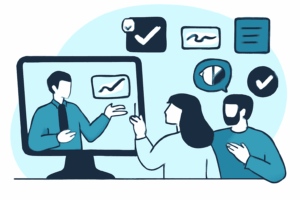Want to know the secret to getting more done each day? Sometimes, it really does come down to learning how to type faster. Whether you’re pecking out emails with two fingers or constantly correcting typos, slow typing feels like watching paint dry. If you’re a professional looking to reclaim valuable time, you’re in the right place.
The good news? You don’t have to be a coder or a stenographer to boost your words-per-minute (WPM). Today, you’re going to learn how to type faster with a few easy techniques and a little patience. Let’s dive in.
1. Find Your Baseline with a Typing Test
First up, before you can improve, you need to know where you stand. Take a free online typing test from sites like Typing.com or Ratatype to measure your current WPM and accuracy.
Don’t worry about the score. The key is to get a baseline. This helps you set realistic goals and, more importantly, celebrate your improvement over time. In fact, seeing that number climb is one of the most powerful motivators.
2. Focus on Accuracy Before Speed
It sounds counterintuitive, right? But speed without accuracy is useless. Constantly hitting the backspace key will kill your momentum and slow you down far more than typing deliberately.
Here’s how it works:
- Slow down and focus on hitting the correct keys.
- Let your fingers build the correct muscle memory.
- Once you can type a full sentence without errors, then you can start to gradually pick up the pace.
3. Learn to Touch Type (Stop Looking at the Keyboard!)
The single biggest leap in typing speed comes from touch typing. That means typing without looking at your hands, relying solely on muscle memory.
Here’s the deal: your fingers can move much faster than your eyes can hunt and peck for keys. It’s a whole different ball game. Online programs like TypingClub offer interactive lessons that guide you through the fundamentals, key by key.
4. Master Your Posture
Believe it or not, how you sit has a huge impact on your typing. Good posture reduces physical strain, which in turn prevents fatigue and keeps you typing comfortably for longer.
Keep in mind these simple rules:
- Sit up straight with your feet flat on the floor.
- Keep your elbows at a comfortable 90-degree angle.
- Your wrists should hover slightly above the keyboard, not rest heavily on it.
5. Practice Consistently, Not Just Intensely
Like learning a new language, consistency is everything. Set aside just 10 to 15 minutes each day for focused practice. This is much more effective than one long, grueling session per week. Daily practice reinforces muscle memory and makes typing feel more natural over time.
6. Get the Right Keyboard for You
Not all keyboards are created equal. If typing is a big part of your day, investing in a keyboard that suits you can make a world of difference.
- Ergonomic keyboards: These are designed to put your hands in a more natural position, reducing strain.
- Mechanical keyboards: Many typists love the tactile feedback and satisfying “click” of mechanical keys, which can make typing more responsive and enjoyable.
7. Learn Essential Keyboard Shortcuts
A BIG part of overall speed isn’t just typing words, but navigating your computer. Fumbling with your mouse to copy, paste, or find a file interrupts your workflow.
Mastering a few key shortcuts saves an insane amount of time. For example:
Ctrl + C(Copy),Ctrl + V(Paste),Ctrl + X(Cut)Ctrl + F(Find)Ctrl + S(Save)Alt + Tab(Switch between windows)
8. Work Smarter, Not Harder: Use an AI Typing Agent
Here’s the kicker: for some tasks, even typing at 100 WPM isn’t fast enough. Think about transcribing a 60-minute meeting. That’s a GRIND. Instead of trying to type every single word, the smartest move is to not type at all.
This is where a proactive typing agent like Proactor AI comes in. It completely changes the game.
- It handles the heavy lifting: For tasks like taking meeting notes, Proactor transcribes the entire conversation in real-time. This frees up your hands and your brain to focus on the discussion itself.
- It saves you post-meeting typing: Better yet, it automatically generates summaries, key takeaways, and to-do lists. This can save you hours of typing and organizing notes each week.
- It lets you focus your skills: By automating the most tedious typing tasks, Proactor lets you apply your hard-earned typing skills where they matter most—crafting that perfect email, writing an insightful report, or coding your next project.
9. Set Small, Achievable Goals
Don’t try to go from 40 WPM to 100 WPM in a week. That’s a recipe for frustration. Instead, set small, realistic goals. For example, aim to increase your speed by 5 WPM each month, or focus on improving your accuracy by 1%. Small wins build momentum.
10. Track Your Progress
What gets measured gets managed. Tracking your improvement is essential for staying motivated. Use a spreadsheet to log your WPM and accuracy from your weekly typing tests. Watching those numbers steadily climb—even by a little bit—is incredibly rewarding and will inspire you to keep going.
The Verdict: A Blend of Skill and Smart Tools
The bottom line is this: learning how to type faster in 2025 is a combination of two things: solid fundamentals and the intelligent use of modern tools. By mastering touch typing and good habits, you build a powerful physical skill. And by offloading the heaviest tasks to an AI assistant like Proactor, you ensure that skill is always used for the most important work.






